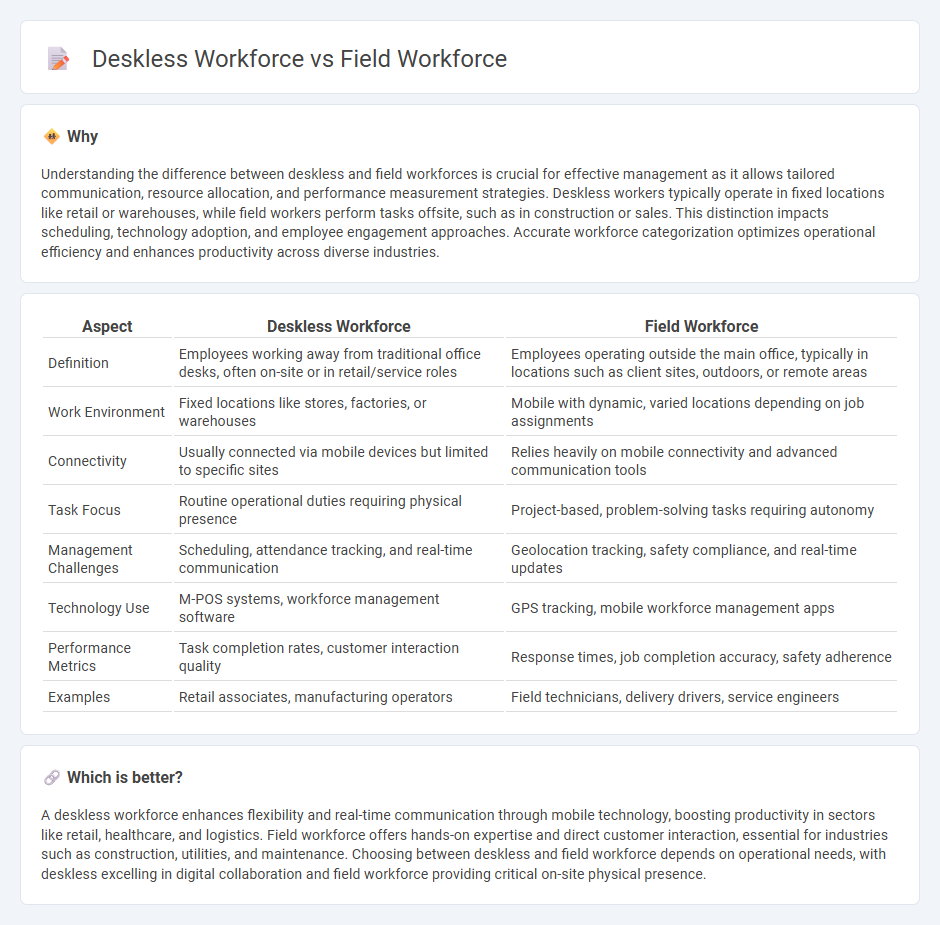
Management of deskless workforce and field workforce requires tailored strategies to address distinct operational environments and communication needs. Deskless workers, often mobile and tech-dependent, benefit from digital tools that enhance real-time collaboration and task tracking, while field workforce management emphasizes location-based monitoring and resource allocation for efficiency. Explore advanced management techniques to optimize productivity and engagement across both workforce types.
Why it is important
Understanding the difference between deskless and field workforces is crucial for effective management as it allows tailored communication, resource allocation, and performance measurement strategies. Deskless workers typically operate in fixed locations like retail or warehouses, while field workers perform tasks offsite, such as in construction or sales. This distinction impacts scheduling, technology adoption, and employee engagement approaches. Accurate workforce categorization optimizes operational efficiency and enhances productivity across diverse industries.
Comparison Table
| Aspect | Deskless Workforce | Field Workforce |
|---|---|---|
| Definition | Employees working away from traditional office desks, often on-site or in retail/service roles | Employees operating outside the main office, typically in locations such as client sites, outdoors, or remote areas |
| Work Environment | Fixed locations like stores, factories, or warehouses | Mobile with dynamic, varied locations depending on job assignments |
| Connectivity | Usually connected via mobile devices but limited to specific sites | Relies heavily on mobile connectivity and advanced communication tools |
| Task Focus | Routine operational duties requiring physical presence | Project-based, problem-solving tasks requiring autonomy |
| Management Challenges | Scheduling, attendance tracking, and real-time communication | Geolocation tracking, safety compliance, and real-time updates |
| Technology Use | M-POS systems, workforce management software | GPS tracking, mobile workforce management apps |
| Performance Metrics | Task completion rates, customer interaction quality | Response times, job completion accuracy, safety adherence |
| Examples | Retail associates, manufacturing operators | Field technicians, delivery drivers, service engineers |
Which is better?
A deskless workforce enhances flexibility and real-time communication through mobile technology, boosting productivity in sectors like retail, healthcare, and logistics. Field workforce offers hands-on expertise and direct customer interaction, essential for industries such as construction, utilities, and maintenance. Choosing between deskless and field workforce depends on operational needs, with deskless excelling in digital collaboration and field workforce providing critical on-site physical presence.
Connection
Deskless and field workforces are connected through mobile technology and cloud-based management systems that enable real-time communication, task tracking, and data sharing. These tools streamline scheduling, enhance collaboration, and improve operational efficiency across dispersed teams. Integrating workflows ensures seamless coordination between on-site and remote employees, supporting better management outcomes.
Key Terms
Mobility
The field workforce operates primarily outside traditional office settings, relying heavily on mobile technologies to perform tasks on-site, while the deskless workforce includes all employees who do not work at a fixed desk and depend on mobile devices to stay connected and productive. Mobility solutions like mobile apps, real-time communication tools, and GPS tracking are essential for both groups to enhance operational efficiency and responsiveness. Explore comprehensive strategies to optimize mobility for your workforce and maximize productivity.
Remote Supervision
Remote supervision enhances efficiency in both field workforce and deskless workforce by leveraging real-time communication tools and mobile technology. Field workforce often requires on-site task management and location tracking, while deskless workers benefit from seamless access to updates without permanent workstations. Explore innovative remote supervision solutions to boost productivity and operational control.
Real-time Communication
The deskless workforce, comprising employees who operate outside traditional office settings, relies heavily on real-time communication tools to enhance productivity and coordination, unlike the conventional field workforce that often utilizes scheduled check-ins and reporting systems. Efficient real-time communication technology, such as mobile apps and instant messaging platforms, enables deskless workers in industries like retail, healthcare, and logistics to respond swiftly, share updates instantly, and improve operational efficiency. Explore how adopting advanced communication solutions transforms workforce management by bridging gaps between field and deskless employees.
Source and External Links
How to Improve Field Workforce Management Efficiency - Field workforce management involves organizing, scheduling, and enhancing mobile teams to increase job efficiency by keeping jobs on schedule, maintaining technician productivity, and ensuring customer satisfaction through specialized software and best practices.
What is a Mobile Workforce in Field Service? - A mobile workforce in field service consists of remote employees and contractors using mobile technology to perform tasks from any location, boosting flexibility, operational efficiency, and customer service responsiveness.
Strategies For An Effective Field Service Workforce - Effective field workforce management focuses on future planning, adopting outcome-based hiring to balance experienced and new talent, and incorporating gig economy workers to address talent shortages in a shifting industry.
 dowidth.com
dowidth.com